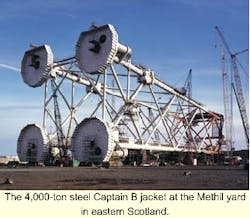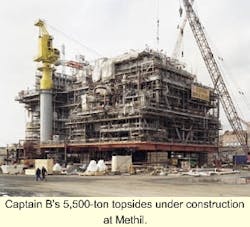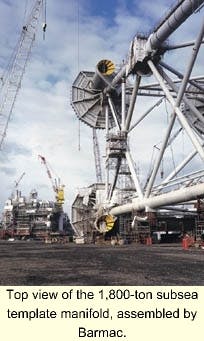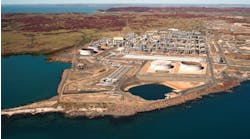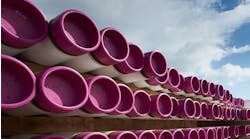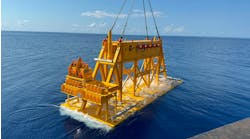Texaco describes the Captain Field in the UK North Sea as a "major asset" in its global portfolio. This is just as well, since Captain certainly presents more than a fair share of challenges. The field lies in approximately 350 ft water depth on the edge of the outer Moray Firth (Block 13/22a), some 68 miles north east of Aberdeen. Discovered in 1977, it was 20 years before the field entered continuous production. During the 1990s, the advent of horizontal drilling, improvements in the reliability of downhole electric pumps, and the introduction of floating production facilities combined to enable the first phase of the field's development. The project, targeted on the western part of the reservoir (designated Area A), cost £500 million to execute. Soon after the start of production, Texaco began to plan for a second phase, Area B, to exploit the eastern area. Developing this region - first oil is expected at the end of this year - has demanded further innovation and an additional investment of about £350 million.
The Captain reservoir is estimated to contain a total of 900 million bbl of oil and 53 bcf of gas. Texaco expects to recover about 30% of the oil in place over the field's 20-year life. This rather low percentage is due to a number of factors. Foremost is the oil's high viscosity - an API gravity of 19°-21°. This, combined with a low gas to oil ratio of between 85-130, means that bringing the oil to the surface requires considerable effort.
There is also a great deal of water present in the reservoir, with which the oil forms stable emulsions that are difficult to break up. Finally, the reservoir, which is about 3,000 ft beneath the surface, contains unconsolidated sands, extends over an area of around 12 km by 6 km and is relatively shallow. In some areas the oil-bearing layer is as little as 70 ft thick.
Expanding production
Currently, Captain Area A delivers approximately 60,000 b/d of oil. The oil is produced via a wellhead platform to a floating production, storage, and offloading (FPSO) vessel capable of storing 550,000 bbl of oil. A dedicated shuttle tanker is used for export. There are 19 producing wells, five water injection wells, and two aquifers, which provide water capable of being re-injected without treatment of any kind. On completion of the Area B project, production will be increased to 100,000 b/d, and for the first time there will also be a gas stream, which is expected to peak at around 30 MMcfd.
Area B will produce from a subsea template manifold sited over a single drilling center some 4.5 km from the Area A wellhead platform. There will be a new platform for the additional processing equipment and utilities, which will be bridge-linked to the existing one. Oil from both Area A and B will be processed on the new platform before being routed to the FPSO for final treatment. The gas will be exported from the new platform via an 8-in. pipeline extending 52 km to the Frigg UK Gas Transport System trunkline, and thence to St Fergus on the Scottish mainland.
Donald Macraild, Texaco's manager for the expansion project, outlined the reasoning behind the new facilities. "Our first thoughts were to produce Area B via a subsea facility directly to the FPSO. However, we discounted this because of the difficulty of making the necessary modifications to the vessel without bringing it back to the shore. The concept we finally selected allows us to undertake the Area B expansion project without unduly affecting production from Area A."
The decision to install a new platform has given Texaco the opportunity to re-evaluate the production philosophy for the entire field. Macraild explained that the FPSO was built with minimum facilities and before Texaco had "really begun to understand the reservoir." The impression is that the vessel's availability during its first three years in production has not been as high as Texaco would have wished.
The second phase development has included a fresh reliability and availability analysis covering all the field's facilities. These findings have been incorporated into the design of the new platform with the result that the company expects to see a "significant improvement in production uptime."
More problems than benefits
"The gas present in the eastern end of the reservoir is not such a benefit to us. In fact, it was viewed by some as a possible 'show-stopper' as far as the development of Area B was concerned," said Macraild. "It is hard enough managing the fluids from Area A but now we have three-phase flow to contend with."
The difficult nature of the production stream from the new Area B wells is reflected in the design of the subsea template manifold. One of its key features is the ability to direct the well fluids along one of two parallel paths, depending on how much gas it contains. The template manifold is also state-of-the-art with regard to chemical injection, essential to assuring decent production flows. It is interesting to note that Texaco spent £4 million on chemicals for Area A during the last 12 months.
The 1,800-ton subsea structure has been designed and built at Barmac's Ardersier yard near Inverness by a joint venture between Cameron and Brown & Root. Costing about £40 million, it has 18 slots. Of these, 14 will be used for Area B - 12 producer and two injector wells are planned. Texaco anticipates using the four additional slots for wells into the underlying Ross Sands formation at some time in the future.
The manifold also has the ability to take in production from a further four-slot stepout which will eventually be used to produce the easternmost part of the reservoir. Cameron is supplying fairly standard 5-in. by 3-in. spool trees, designed for working pressures of 6,170 psi and temperatures of between 35-250°F. The company claims the associated control system is, however, notably advanced. The Camtrol multiplexed system has been designed with dual redundancy and the claimed advantages include the following:
- Modular hardware and software
- Open architecture both at the surface and subsea
- High fault tolerance
- Above average availability and rapid response.
Cameron also points out that the subsea modules are compact, lightweight, and easily retrievable using remotely operated vehicles (ROV). It is supplying an almost identical system to the Shell Malampaya project in the Philippines, where Brown & Root is again responsible for the subsea engineering.
Submersible pumps
The presence of gas in Area B has forced Texaco to seek an alternative to the electric submersible pumps used in all the Area A producing wells. The company harbors reservations about subsea electrical power distribution and in any case considers electrically powered pumps unsuitable because of their tendency for gas locking when there is in excess of 40% gas in the production stream.
Texaco has collaborated with Weir for the past few years, with support from the UK Department of Trade and Industry, to develop a multi-phase variant of Weir's hydraulic submersible pump. The result is a device for handling production fluids with gas void fractions up to 95% on a continuous basis, and up to 100% in a transient gas slugging regime.
The hydraulic turbine has an inherent variable speed capability and will automatically speed up or slow down as the properties of the produced fluid entering the pump change. The low inertia rotor enables the pump to react almost instantaneously to composition changes. Weir claims an acceleration of 2,000 rpm in under 0.5 seconds.
Clean, treated water is used to power the pump's 25-stage turbine. This same water is used for bearing lubrication, which minimizes wear when compared to a normal pump using produced fluids as the lubricant. On the down side, the power water becomes intimately mixed with the oil, adding to the separation and water handling problems that have to be dealt with later on.
The successful trial of a prototype pump in an Area A well, C-13, during 1998, gave Texaco the confidence to specify the newly-developed pumps exclusively throughout Area B.
Bridge-linked platform
The new bridge-linked platform is being designed and built by Kvaerner at its Methil yard, near Edinburgh. A 5,500-ton topsides, which will be fully commissioned onshore, will be supported on a steel jacket weighing 4,000 tons. Only four piles will be needed to secure the structure to the seabed.
Designed with improvements to the availability of the entire field in mind, the principal features of the new platform are separation facilities to knock out free water and gas from the production stream - an enhanced cyclone inlet device will assist gas separation - and heaters to raise the temperature of the oil to 50°C prior to delivery to the FPSO. The field's water handling capacity will be increased from 230,000 b/d of water to 400,000 b/d and provision will be included to export up to 30 MMcfd of gas. Multi-phase metering will avoid the need for a test separator with subsequent weight and space savings.
In common with most other current North Sea developments, considerable attention has been paid to environmental issues. There are high standards of waste heat recovery and produced water discharge to the sea has been eliminated. Export of the gas will avoid flaring. In later life - gas production is expected to last for five years - the same pipeline will be used to re-import gas to run the platform's gas turbine power generators.
Relatively few modifications are required to the existing platform and the FPSO. The former receives additional accommodation, another lifeboat and a revision of its control system - the new platform will be controlled from the existing one. The FPSO has had its electrostatic coalescer, used to remove the last traces of water, improved with the water handling facilities upgraded.
Gravel pack record
The area where innovation has probably been greatest on Captain is downhole. Area A has made extensive use of horizontal drilling. The operator has worked with Anadrill Schlumberger on advanced geosteering technology with the result that it has been possible to drill wells deviating by as little as 2.5 ft over horizontal sections of 4,000-7,000 ft.
Graeme Rae, Texaco drilling manager on Area B, pointed out that water-based muds are now being used exclusively on Captain at the same time as significant advances are being made in gravel packing technology. "The presence of highly unconsolidated sand in the formation increases substantially the chances of the well screen becoming blocked in some places, which can lead to erosion in neighboring areas and ultimately breakdown of the screen leading to well failure," Rae said.
In an effort to improve the reliability and prolong the life of the wells under these difficult conditions, Texaco approached Baker Tools, which in turn supplied 230-micron all-metal, Exluder well screens designed specifically for this sort of service.
New techniques, fluids, and equipment have also been jointly developed to enable specially-sized gravel to be packed in the space between the 5.5-in. screen and the 8.5-in. diameter hole. The result is that horizontal sections as long as 4,000 ft have been successfully treated. This is apparently a world record - the previous best in a horizontal well was 2,000 ft. Up to 60 tons of gravel are needed in these cases.
The plan for Area B will involve pushing the limits further out for both horizontal drilling and gravel packing. The longest well on Area A was 11,500 ft. It is anticipated that some of the Area B wells will extend to 13,000 ft. Four of the wells are expected to involve extended reach drilling (ERD) techniques. It is also hoped to increase the gravel packed horizontal lengths to 5,000 ft, initially with an ultimate target of 8,000 ft.
Ahead of schedule
Leaving aside the technology, the most impressive feature of the Captain Area B expansion project has been its rapid timescale. The Area B development was sanctioned in February 1999. Engineering work on the platform had begun prior to that date, allowing fabrication of the platform to begin almost immediately. Long lead-time items had been conditionally ordered by Texaco well before it let the contract for the platform. Manifold engineering started a little later in April 1999 and fabrication of this structure was under way by June 1999.
Work on all the new facilities is almost complete, as are modifications to the FPSO and the existing platform, and the target is to install the platform jacket and the manifold in June of this year and the topsides in July. Saipem has the contract for the manifold, and Heerema the jacket and topsides. All in-field pipelines have been laid by Coflexip Stena Offshore and the gas export line is also on schedule. Hook-up and commissioning should be finished during August, allowing existing production from Area A to be processed through the new facilities at the end of that month.
Drilling on Area B is due to start at the beginning of August using Transocean Sedco Forex's Sedco 704 drilling rig. The aim is to have first oil from Area B by the end of December of this year, although the project has a stretch target of October. The drilling program will continue for 26 months and cost in the region of £65 million.
Donald Macraild credited the contractors and vendors involved with the Area B expansion. The fact that many of the Texaco staff involved in Area A came directly over to the Area B development has also contributed to the smooth delivery of the project.
The principle contracts for the Area B manifold and the platform have both been lump sum engineering, procurement, installation and commissioning (EPIC) contracts. It is interesting to note that Macraild felt that Texaco had to some extent "lost control" of the Area A development project, which was carried out as a single alliance of a number of contractors. "Although conventional contracting strategy has been employed on Area B, the commitment, openness, and teamwork have been impressive. This has been a major factor in the success of the project," he said.
